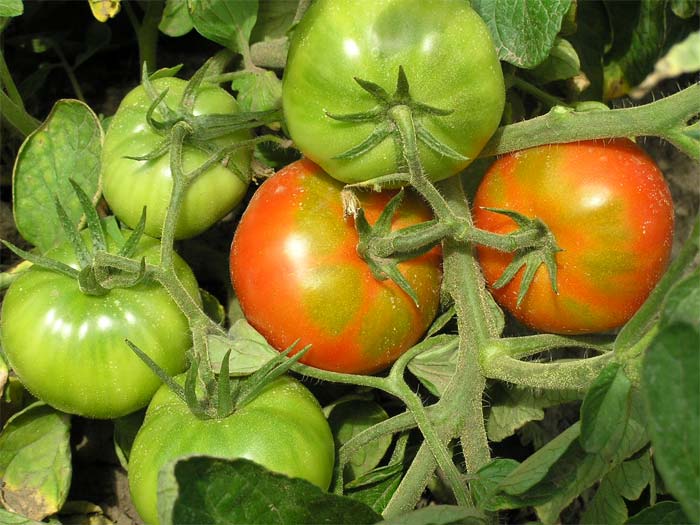 Even the strongest, well-developed tomato bushes sometimes give a weak crop. The problem may be associated with unstable, variable weather with sharp changes in day and night temperatures.
Even the strongest, well-developed tomato bushes sometimes give a weak crop. The problem may be associated with unstable, variable weather with sharp changes in day and night temperatures.
Sometimes the loss or absence of ovaries is a signal of a lack of nutrients in the soil or the abnormal formation of a bush. The problem is solved, moreover, there are ways to increase the yield of tomatoes.
Content
What tomatoes need for good fruit setting
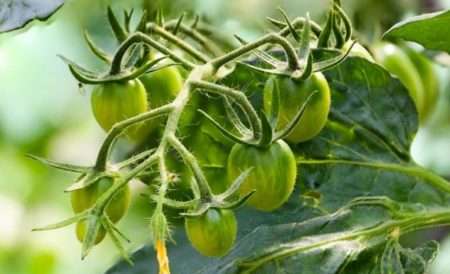 The main thing when growing tomatoes is not the selection of a productive variety, but the observance of the rules of agricultural technology. Each culture has its own preferences in watering and top dressing. Excess moisture, nutrients leads to the growth of green mass to the detriment of the fruit or the development of diseases. Lack of any nutrition entails poor development and reduced yields.
The main thing when growing tomatoes is not the selection of a productive variety, but the observance of the rules of agricultural technology. Each culture has its own preferences in watering and top dressing. Excess moisture, nutrients leads to the growth of green mass to the detriment of the fruit or the development of diseases. Lack of any nutrition entails poor development and reduced yields.
Many gardeners call tomatoes a draft-loving plant. This is because for normal pollination, culture needs a periodic “shake”.
Most tomato varieties require garter, molding and removing excess foliage. The plant is thermophilic, but it also does not tolerate extreme heat, like cold. Gusty, winds not only lead to damage to the bush, but also interfere with normal pollination.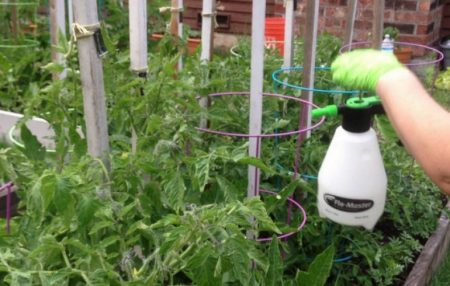
How to create favorable conditions for tomatoes:
- In cool regions, only heat-loving, hardy varieties can be planted in open ground, the rest are placed in a greenhouse.
- For a tomato, an open, sunny place is allocated.
- The soil on the site should be cultivated, loose, light, well permeable to moisture and air. The optimum pH is from 5.5 to 6.5.
- Tomatoes will be poorly tied and constantly sick if you plant them every year in the same place.
- Dense plantings are extremely undesirable, even for undersized varieties. The distance between the bushes should be at least 40 cm.
- In normal weather, tomatoes are watered once a week, in the heat every 2 days, using only warm water.
- To determine when and how to feed tomatoes, you need to monitor the bushes, take into account the general condition of the soil. If the leaves have become too fleshy, then the tomatoes are fattening, you should stop feeding them with nitrogen. If a purple shade of the leaves is observed, this indicates a lack of phosphorus, they dry on the edges - there is little potassium.
- Information on the correct formation of the bush is written on the packaging with seeds, it is important to follow the recommendations, the extra branches will not contribute to increasing yields, on the contrary, they will greatly weaken the bush.
- Tomatoes do not like neighborhood with weeds, excess grass clogs the crop, attracts harmful insects to the beds.
- Treatment from pests and diseases should be carried out at the first sign of damage, chemistry is used only according to the instructions, observing the recommended interval between treatment and the start of collection.
Tomato is a rather capricious culture that requires attention, especially if the main goal is to get the largest possible crop. Unfortunately, varieties for which it is permissible to take care only on weekends are very few.
Why tomatoes are not tied in the open ground
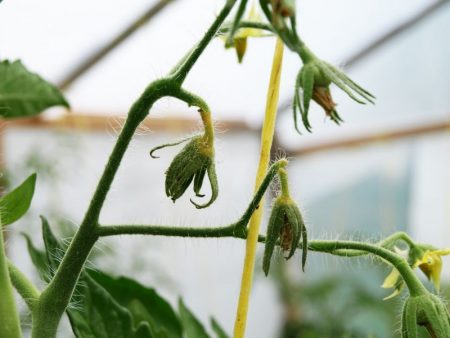 To find the right way to increase tomato yields, you need to correctly determine the reason for the decrease in the number or absence of ovaries. When identifying a problem, one should proceed from the general requirements of the culture to the growing conditions.
To find the right way to increase tomato yields, you need to correctly determine the reason for the decrease in the number or absence of ovaries. When identifying a problem, one should proceed from the general requirements of the culture to the growing conditions.
Temperature and humidity
The optimum daily temperature for tomatoes would be + 23–29 ° (maximum 30–32 °, but short-term) during the day and + 18–21 ° at night. Tomatoes will slow down in development, will cease to set when the daytime temperature rises and settles at 37–40 °. Without normal watering in the heat, tomatoes will lose a significant part of the flowers that have not yet been pollinated, only the resulting brushes will dry out.
Cold-resistant varieties can tolerate short-term cooling to + 13 ° (at night) without loss. But it’s better not to experiment, keep track of forecasts and provide plants with protection.
Tomatoes are most comfortable when the soil moisture is 60–70%. Exceeding the norm leads to the fact that the pollen on the flowers sticks together, does not get enough sleep. Low humidity will cause the pollen that has fallen on the pestle to not sprout, the fruits will not set.
It is impossible to influence the weather, but it is possible to help tomatoes easier to endure adverse periods:
- with a significant decrease in night temperature for the bushes, build temporary shelters. It is enough to install light frames and dense covering material, which will be easy to remove during the day;
- during frequent rains, remove the mulch and loosen the earth around the bushes as often as possible. If possible, thin out the foliage so that the plants dry quickly and are well ventilated;
- so that in the heat and drought the moisture does not evaporate quickly, cover the beds with a good layer of mulch;
- To protect fruits and young brushes with buds from direct sunlight, shade the bushes with a special mesh. The material can not be laid directly on the branches, it is pulled on light, makeshift structures.
Tomatoes easily tolerate short-term weather changes. But if you do not take any measures to protect in protracted unfavorable periods, you can forget about a good harvest.
Pollination
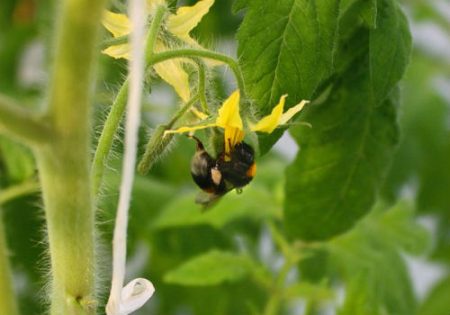 Tomato is a self-pollinating plant, usually it does not need additional help from insects, just a light wind. Most often, pollination problems occur in greenhouses, but also in open ground, pollen dies at a stable temperature of 32 ° or more, especially with high humidity.
Tomato is a self-pollinating plant, usually it does not need additional help from insects, just a light wind. Most often, pollination problems occur in greenhouses, but also in open ground, pollen dies at a stable temperature of 32 ° or more, especially with high humidity.
To determine whether the crop will be, you need to weakly, but sharply knock on the peduncle. If a small light cloud of pollen flies out of the flower - this is a good sign, the absence of pollen, protruding stigmas on a long column - evidence that the process is broken.
You can help tomatoes pollinate by arranging a light shake in the bushes, the procedure must be carried out several times in the morning (9-11 hours). Another option for self-pollination involves the use of an ordinary artistic brush. The bristles of the brush should be gently inserted into the pistils of the fully opened flowers with an intense color.
Fertilizers
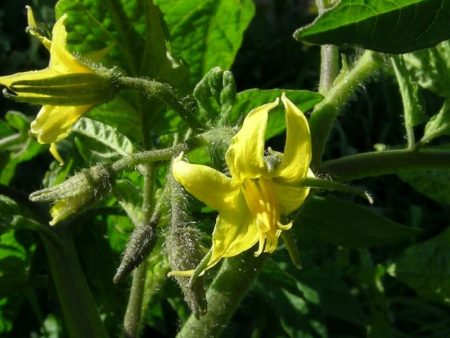 The number of ovaries is reduced due to improper, unbalanced nutrition. It is advisable to use any nitrogen-containing fertilizers, including organic ones, before flowering begins. The first session is carried out approximately 10-14 days after planting, after the same period of time the procedure is repeated, you can change the type of nitrogen fertilizer and feed the tomatoes on a leaf.
The number of ovaries is reduced due to improper, unbalanced nutrition. It is advisable to use any nitrogen-containing fertilizers, including organic ones, before flowering begins. The first session is carried out approximately 10-14 days after planting, after the same period of time the procedure is repeated, you can change the type of nitrogen fertilizer and feed the tomatoes on a leaf.
During the season, from 3 to 6 sessions of root and foliar top dressing may be required.
Starting from the period of mass flowering, fertilizing with complex fertilizers is carried out, where the percentage of potassium and phosphorus is higher than nitrogen. Otherwise, the bush will begin to actively grow green mass to the detriment of the formation of fruits. Among mineral complexes such means are especially popular:
- "Universal";
- "Kemira wagon-2";
- nitroammophosk;
- "Mortar".
Any drug is used strictly according to the instructions.Do not exceed the norms and frequency of application, this can give the opposite effect. When the first brush blooms and at the beginning of the formation of ovaries for foliar fertilizer, you can use superphosphate (a teaspoon in a bucket of water). All top dressing is carried out only in the morning and in the evening, after watering with an interval of at least 15 days.
Other causes of poorly set tomatoes
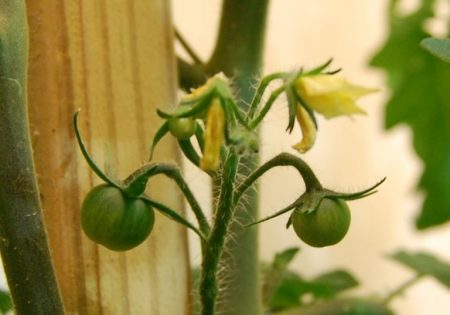 When buying seeds, be sure to pay attention to the recommended conditions, tomatoes intended for open ground should not be planted in a greenhouse, and vice versa. You need to remove the extra stepsons while they are still small, the bush wastes a lot of food on growing branches, while the ovaries develop very poorly.
When buying seeds, be sure to pay attention to the recommended conditions, tomatoes intended for open ground should not be planted in a greenhouse, and vice versa. You need to remove the extra stepsons while they are still small, the bush wastes a lot of food on growing branches, while the ovaries develop very poorly.
Secrets of increasing ovaries on tomatoes
How to save and increase tomato productivity will tell us the experience of experienced gardeners who are happy to share their secrets. All tips and tricks should be used wisely and on time. It is impossible to overload bushes, especially if there is no reliable, strong support for a garter. It is important not only the number of fruits, but also the quality that can suffer with an excessively large number of fruits.
Tomato Tricks:
- Tomatoes need to be planted before the first brush appears, seedling hardening is required;
- in the greenhouse place beds with tomatoes in the direction from east to west. This will allow the sun to evenly illuminate all the bushes in the morning and afternoon;
- timely hilling will strengthen the root system. The first time the soil is raked up, when subtle tubercles appear in the lower part of the stems, the second time when the stalk near the ground itself changes its green color to brown-blue.
Hilling not only helps to expand the nutritional area of the bush, increase the number of ovaries, but also save plants affected by frostbite or disease. Especially when heavily trimmed.
Processing tomatoes with folk remedies to increase the ovaries
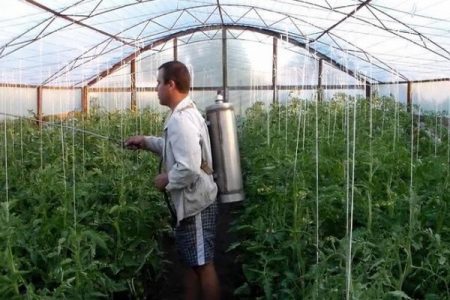 Do not spare time and energy for caring for tomatoes, do not stop at chemical stimulants of productivity, pay attention to other options. Check out reliable, proven recipes for spraying and fertilizing tomatoes, they are easy to prepare and do not require serious financial expenses.
Do not spare time and energy for caring for tomatoes, do not stop at chemical stimulants of productivity, pay attention to other options. Check out reliable, proven recipes for spraying and fertilizing tomatoes, they are easy to prepare and do not require serious financial expenses.
Wood ash
Ash - a source of potassium and phosphorus, helps to stimulate the flowering and fruiting of tomatoes. A tablespoon of ash is poured into 2 liters of hot water, mixed, covered with a lid and insisted for a day. Before use, the liquid is filtered, half a liter of infusion is poured under one bush. Fertilization with ash can be carried out once every 1-2 weeks.
For foliar top dressing, the solution is prepared differently - 600 grams of ash are stirred in 6 liters of water, boiled for 30 minutes and left to infuse for 5 hours. The liquid is brought to a volume of 20 liters and 80 grams of laundry soap is added. The resulting solution is filtered and begin to spray.
Eggshell
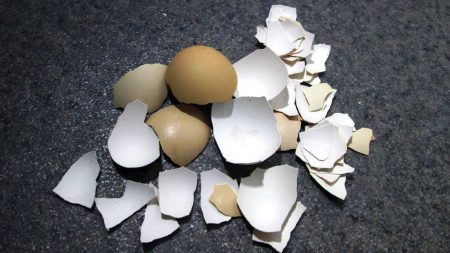 The tool is considered a good complex nutrition for tomatoes. Crushed shells of 3-4 eggs are poured into 3 liters of water, tightly covered with a lid, insisted for 3 days in a dark, warm room. As soon as the infusion darkens, it gets an unpleasant odor - it is ready for use. Most often, eggshells are used in growing seedlings, however, with this infusion, you can water the bushes at the stage of active vegetation. After the main watering, 200 grams of fertilizer is enough for one plant.
The tool is considered a good complex nutrition for tomatoes. Crushed shells of 3-4 eggs are poured into 3 liters of water, tightly covered with a lid, insisted for 3 days in a dark, warm room. As soon as the infusion darkens, it gets an unpleasant odor - it is ready for use. Most often, eggshells are used in growing seedlings, however, with this infusion, you can water the bushes at the stage of active vegetation. After the main watering, 200 grams of fertilizer is enough for one plant.
Iodine
A mixture of 20 drops of iodine, a liter of serum and a tablespoon of hydrogen peroxide will help get rid of phytophthora and get the most rich tomato crop (the amount of ingredients is calculated per bucket of water). Fertilize the tomatoes with a solution not after watering, but instead, the procedure is carried out 2 times a month. The recipe is also suitable for spraying, which can be repeated every 10 days.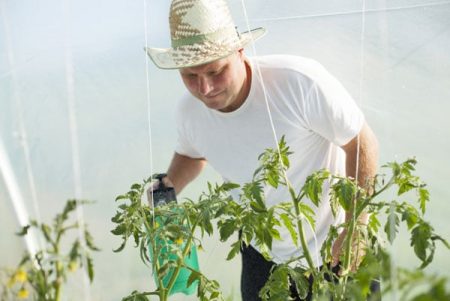
If during seedling cultivation, once pour already grown bushes with a weak solution of iodine (2 drops per 4 liters of water), then in the future the plants will bloom and tie more actively. The brushes will become branched, large and strong.
Any top dressing and spraying should be carried out in the morning or in the evening. During the day, procedures are permissible only in cloudy weather, when there is no risk of precipitation. If it rains after the surface treatment of the tomatoes, the procedure is repeated after 2 or 3 days.
Banana peel
Fertilizing tomato seedlings with a banana peel contributes to the establishment of strong immunity in plants, the ability to actively tie and form large, tasty fruits. Watering young tomatoes with such a solution will contribute to the accumulation of potassium, the lack of which negatively affects the process of assimilation of nitrogen.
In a 3 liter jar, put skins from 3 or 4 bananas, pour warm water and insist 3 days. Watering the bushes is necessary until the soil is completely wet, not more than once a week. You can store the infusion in the refrigerator, but before use it is warmed to room temperature.
Boric acid
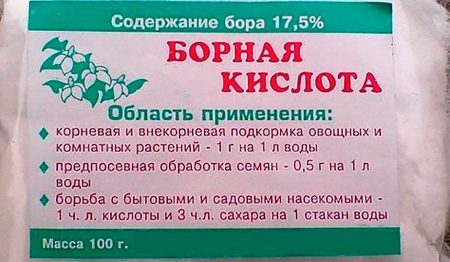 The substance is involved in the transport of calcium to all parts of the plant, accelerates the growth of shoots, helps to preserve flowers and form fruits. Some gardeners recommend adding a little powder to the wells a day before planting, but it is better to spray the bushes with the product during active vegetation.
The substance is involved in the transport of calcium to all parts of the plant, accelerates the growth of shoots, helps to preserve flowers and form fruits. Some gardeners recommend adding a little powder to the wells a day before planting, but it is better to spray the bushes with the product during active vegetation.
5 grams of boric acid is dissolved in a bucket of water, the plants are irrigated evenly, capturing all the stems and the back of the leaves. Remember, the substance is better soluble in hot water. Another version of the mixture - 5 grams of urea, copper sulfate and boric acid is dissolved in 10 liters of water, the treatment is carried out twice with an interval of 2 weeks.
Yeast
Yeast nutrition of tomatoes can be carried out only once, before the start of mass flowering. In a three-liter jar, put 100 grams of sugar and live yeast, pour warm water almost to the top and put in a warm place for fermentation. During fermentation, the mixture is periodically mixed. The resulting liquid is diluted (200 ml of mash on a bucket of water) and watered tomatoes, at the rate of a liter under the bush.
Mineral cocktail
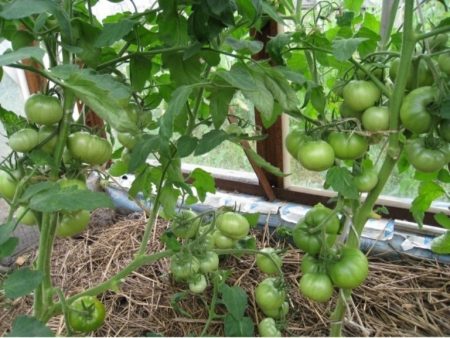 A liter jar of ash is poured into a bucket, pour 2, 5 liters of boiling water, allowed to cool, add 5 grams of boric acid and 5 ml of iodine, add water to obtain 10 liters, insist day. The resulting infusion is diluted with water 1: 1, poured per liter of mixture under each tomato bush. Top dressing can be done once, during the period of mass flowering and the formation of ovaries.
A liter jar of ash is poured into a bucket, pour 2, 5 liters of boiling water, allowed to cool, add 5 grams of boric acid and 5 ml of iodine, add water to obtain 10 liters, insist day. The resulting infusion is diluted with water 1: 1, poured per liter of mixture under each tomato bush. Top dressing can be done once, during the period of mass flowering and the formation of ovaries.
Seasoned gardeners are advised to grow tomatoes on "their land." If in the current season the tomatoes do not get sick, are not affected by pests, in autumn the tops can be planted in the soil. The next year, in the same place to plant culture again. Such advice contradicts the rules of crop rotation, but numerous experiments by summer residents show really good results - the yield increases by 50%.
How to preserve the formed ovaries and increase the mass of fruits
So that the ovaries do not fall, it is important to continue the proper care of the tomatoes until late autumn. Make sure that the plants are not overloaded with excess greens. The foliage at the bottom of the bush needs to be removed as it grows. All yellowed or extra (not covering brushes) leaves, it is desirable to cut off too. Removing the tops will provide ventilation of the bushes, as well as the normal circulation of nutrients in the organs of the plant.
The second important point is pinching. Some gardeners advise to carry out the procedure no more than 3 times during the whole season, however, most tomato varieties continuously give lateral shoots, which grow very quickly and take a lot of power from the plant, it is better to remove them immediately. Tall varieties form in 2–5 stems, no more, stunted ones usually do not require molding, but it is better to check the information on the package.
As soon as you find ugly ovaries on the bushes, immediately tear them off, they will grow huge with a lot of damage inside. Delayed, you will only slow down the development of other fruits.
Many summer residents to form large tomatoes form a bush of no more than 3 stems and remove the first brush. You can also increase the mass of fruits using iodine top dressing, they also contribute to faster ripening of the tomato. Once a week, instead of the usual watering, the bushes should be fertilized with a mixture of 4 drops of iodine per 10 liters of water. Each bush takes 1.5 or 2 liters of solution.
So that the quality of the tomato does not suffer from the quantity, care for the crop should be comprehensive. The process of proper cultivation of tomatoes only seems complicated, in fact everything is very simple, the main thing is not to spare time and constantly monitor the condition of the bushes. Take care, the main goal - getting a plentiful harvest of tasty and large tomatoes will be achieved.




 Low-growing tomatoes, without pinching: 5 of the most delicious varieties
Low-growing tomatoes, without pinching: 5 of the most delicious varieties Why tomato seedlings grow poorly
Why tomato seedlings grow poorly We grow a tomato in a shell
We grow a tomato in a shell Growing tomatoes without watering according to the method of Kazarin
Growing tomatoes without watering according to the method of Kazarin